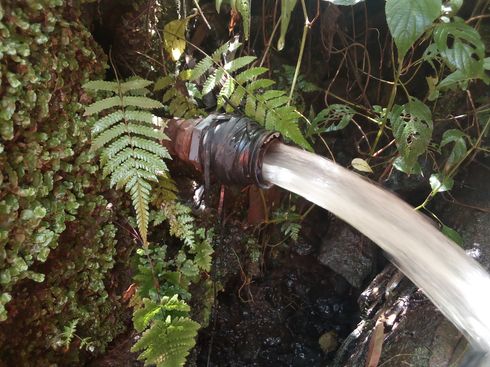Water is vital for life and this applies to farming too. Water is needed by both plants and animals.
The water supply on the farm has gone through a few changes. There is a small river that passes through the farm and is the primary source of water. It is pumped to the farm using various means.
My grandfather had installed a diesel powered water pump some years back. This was costly as the price of fuel, including diesel has been rising throughout the years.

Water flowing from a hydram
At some point there was a hydram pump(hydraulic ram- a kind of pump that only uses the flow of water to pump water) installed by the settler farmers who once inhabited these here parts. It is a very cheap system to run as it doesn't consume any power or fuel, being powered only by the flowing of water.
At some point, the farm had been abandoned and things went into disrepair and some things were vandalized. When we went back to the farm, there was no way to pump water. Water had to be fetched by hand. Needless to say, it wasn't efficient nor Viable to farm in this way.
It was decided that the old trusty hydram should be setup. The one thing that one should consider when setting up a hydram is the drop(difference in height/elevation between the inlet to the pump and the actual location of the pump). The greater the drop, the more pressure/ volume of water that can be pumped. The drop that we have is a medium one so the water volume pumped is not that much. That is the only drawback of the hydram system that was installed. It however operates continuously, day and night.
As the volume of water is not that high, planning to use the water for irrigation farming is not viable, as it can only supply a small area in addition to watering the animals and household use.
This was part of the reason why my coriander farming failed, as the pump couldn't irrigate the whole area under cultivation.
The pump as with any other type of machinery, does fail once in a while and needs repairs. These are usually moving parts, pipe fittings or gaskets. During this time, as repairs are done, a gasoline powered water pump is used. It does pump a large volume of water in a shorter time, but it is expensive to run.
Thoughts on water pumping
one cannot do without water in farming. However it is a key cost to be considered as nothing can grow without water. The best way would be to find the least costly way to irrigate the land. The cheapest is rain fed agriculture. This has constraints as it isn't always raining, and most plants need a fairly consistent water supply.
The other way is mechanical irrigation. This involves moving water mechanically from source to the farm. Electricity would be one of the considerations, if it is readily available and cost effective. Unfortunately in our case the farm is a bit far from the power lines and connecting to the grid is going to cost an arm and a leg.
Solar power is a consideration as we do live in the tropics and we do receive plenty of sunshine. The problem with this is that most solar powered pumps have a lower throughput than the equivalent electric powered ones. They also do have a higher acquisition cost. Lastly they cannot be used on cloudy days as the throughput will be little if any.
Hydram is a good way to pump water. This is because other than the setup and maintenance costs, it is the cheapest to run as it doesn't have direct consumables. The only drawback is that the throughput water volumes aren't high compared to the electric or fuel powered pumps.
All matters considered, I would probably rank them in order of cost effectiveness as electric, solar, hydram and fuel powered.